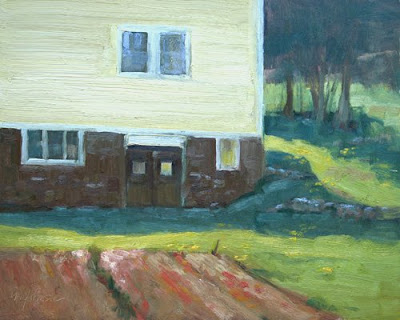If you haven't been painting
en plein air very long, you may find that values get away from you. Lights become too dark, darks become too light, and the design of the painting vanishes in a mid-value Neverland. I have to admit that color is what usually first excites me about a scene, and not value. For me, it's very easy to let values slip when my natural focus is color.
One common method for
plein air painting involves laying in an underpainting with the approximate color and value of the scene. When we paint this way, we're juggling two balls at once. It's not easy. If you find your values slipping as you paint, try doing the underpainting in monochrome. I like Burnt Sienna for this. (Studio painters would call this a
grisaille.) Establish your darkest value with Burnt Sienna right out of the tube, and then thin it with Turpenoid to create the mid-darks, mid-lights and lights. Next, begin to lay in color, taking care to match the values accurately. The Burnt Sienna gives you guide for this.
Even though the Burnt Sienna will still be wet, don't worry about painting
alla prima on top of it. The Burnt Sienna will warm up the painting a bit and create nice greys in your blue sky.
Here's a painting I did this way yesterday. First, the
grisaille, followed by the finished painting and finally a greyscale version of the finished painting.

 "Sunday Quiet"
"Sunday Quiet"6x8, oil, en plein air
SOLD

 Next, here's the first layer of paint applied with a knife.
Next, here's the first layer of paint applied with a knife. Finally, the finished painting. I ended up never getting to the brushes and did it entirely with a knife. Thanks to my premixed values, I was able to keep the values from shifting, and the painting represents the original values closely.
Finally, the finished painting. I ended up never getting to the brushes and did it entirely with a knife. Thanks to my premixed values, I was able to keep the values from shifting, and the painting represents the original values closely.
























